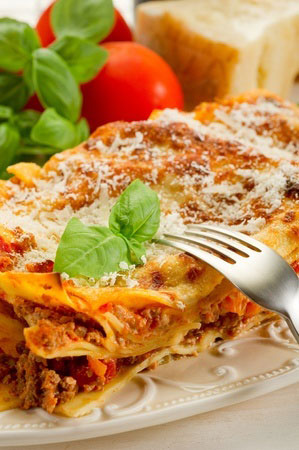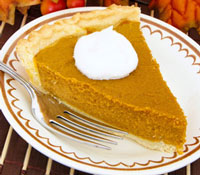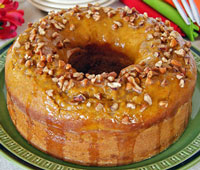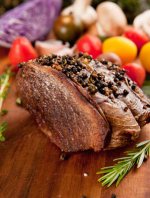How to Make Lasagna with that Homemade Taste

Lasagna is a timeless classic and it certainly is worthwhile learning how to make your own. Plus it really tastes so much better than the store-bought variety.
Learning how to make lasagna really isn’t that hard. Yes, it can be a little time consuming, but you can always make the meat sauce in advance and freeze it. Then all you have to do is make the white sauce and assemble all the layers.
Cooked lasagne also freezes well, so make a large batch and freeze portions for later.
There are probably thousands of lasagne recipes out there, from the traditional meat to spinach, and all equally delicious. Most lasagna recipes are very flexible and can easily be altered, from adjusting portions to using different cheeses, or adding vegetables.
Lasagna consists of three elements:
The Sauce
The Noodles
White Sauce
The Sauce
This is probably the most important part of the dish. The sauce
provides the flavor. Most lasagna sauces begin with a tomato base and
are easily made from either canned tomatoes or passata. What is
passata? Passata is uncooked tomato puree that has been strained of
seeds and skins. If you cannot find it in your store, take plain
canned tomatoes and run them through a sieve or a food mill.
To
this tomato base you then add your other ingredients: herbs such as
basil, rosemary or oregano, garlic and a little sugar to cut the acidity
of the tomatoes. If making a meat sauce add ground beef, veal or
pork. Vegetarian lasagne can be made from zucchini, spinach or roasted
eggplant.
If you are making a lasagna to fit a 9 x 3 inch (23 x 33 cm) lasagna dish, you will need about five cups of tomato sauce.
The Noodles
You can made your own noodles, but I prefer to buy the ready-made
variety. Using dried lasagna noodles that don’t need boiling
definitely cuts down on the work load and makes the process much
easier. Just make sure the sauce has sufficient liquid to soften the
noodles as they cook. Covering the dish with tin foil as it cooks also
helps keep the moisture in while cooking the pasta.
But if you do
use the pre-boil variety, cook until al-dente, which means the pasta
should still be slightly chewy. Adding a little oil to the water will
prevent them sticking. When cooked, drain the noodles then run cold
water over them to keep them separated and lay them flat.
White sauce or Bechamel
Bechamel is easily made from butter, flour and milk and makes a lovely creamy white sauce.
Learn how to make the perfect Bechamel
What cheese to use?
A combination of ricotta, parmesan and mozzarella are the cheeses most typically used in lasagna recipes. The best recipes use a combination. Use either ricotta, mozzarella or a tasty cheese for the white sauce. A combination of parmesan and mozzarella is great sprinkled over the top.
How to Make Lasagna - Easy Steps to Perfection
First you need to make your tomato sauce. If making a vegetarian lasagna prepare your vegetables.
Then you need to make the white sauce or Bechamel. Grate sufficient cheese to add to the Bechamel with enough left over to sprinkle over the top of your lasagna at the end.
Now you need to divide your tomato sauce and béchamel into four equal portions so you have enough for all the layers. There is nothing worse than finding you have insufficient sauce for the top layer. I do this by taking my spoon and roughly drawing lines through the sauce.
Spread sufficient sauce to cover the base of the baking dish. This will prevent the pasta sheets from sticking to the bottom.
Arrange a layer of pasta sheets over the sauce, trimming them to fit if necessary.
Spread one quarter of the white sauce over the pasta sheets.
Cover this with a layer of tomato sauce. It doesn’t really matter whether you layer the meat over the cheese or vice versa. However if you are using dried lasagna sheets, the white sauce helps to soften the pasta.
You need to repeat this layering process twice more starting with the pasta, white sauce and tomato sauce.
Add the final layer of lasagna sheets.
You should now have used all the tomato sauce and have sufficient white sauce to cover these remaining lasagna sheets. You need to make sure the sauce completely covers the pasta, otherwise it will dry out and burn and that’s not good. This is where practice and experience comes in handy. Do this sufficient times and you will be able to judge how much of each sauce to use for the layers.
Sprinkle over the grated cheese.
Cover the dish with tin foil and bake in the oven for the recommended time. This will prevent the cheese from burning and helps the lasagna to cook evenly.
Remove the tin foil and return to the oven for a further 10 – 15 minutes to brown the cheese.
Remove from the oven and leave to stand for at least 10 minutes before serving. This helps to firm up the lasagna and makes cutting it much easier.
Tips
- Before you begin assembling your lasagna, have each component ready and to hand. Cooked lasagna sheets should be cooled sufficiently to handle, the cheese grated and the tomato and white sauce ready to be spooned over the sheets.
- Unless the recipe states otherwise, the standard size baking dish used is a rectangular 13” x 9” (34 cm by 23cm) tin. This will serve 4 – 6 people.
Storing
Any leftover lasagna can be stored in the fridge and eaten the next day or frozen. Cooked lasagna will keep in the freezer for several months.
Home » How to Make Lasagna








New! Comments
Have your say about what you just read! Leave me a comment in the box below.